This sweet potato chickpea curry recipe is vegan and vegetarian. It is full of healthy veggies and plant-based protein. If you love a coconut-based curry, this dish combines coconut milk with Thai curry paste and powder, soy sauce, and lime juice for a warming meal.
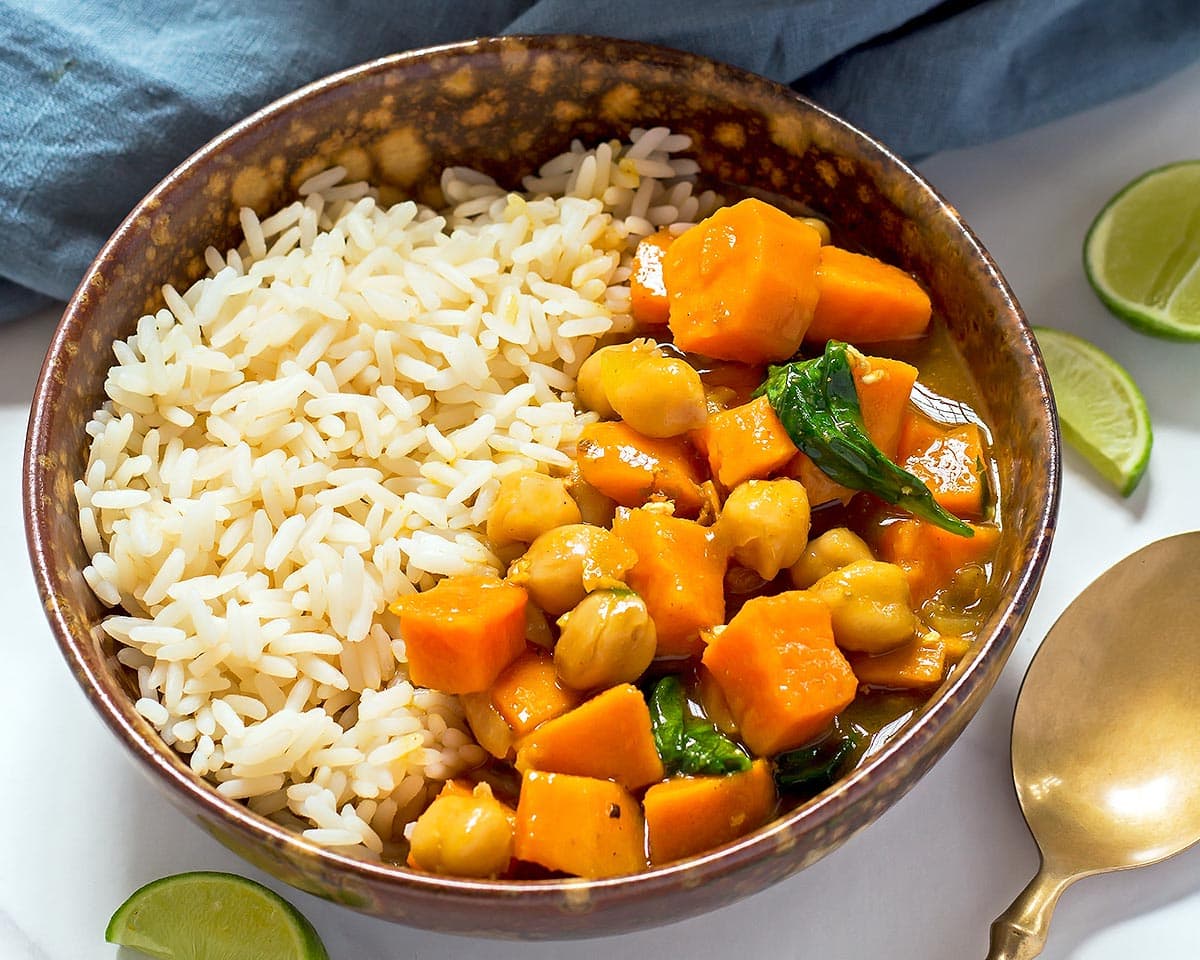
How to Make Chickpea Curry
If you have never made chickpea curry before, or any other type of curry, it is very easy. You don't need any special equipment other than a large pan or skillet to get started.
Every coconut curry needs to begin with some aromatic components to give it an intense and deep flavour. In this sweet potato and chickpea curry recipe, I use finely chopped onion and garlic and sweat them gently over low to medium heat so they soften and become translucent. The heat shouldn't be so high that it burns or browns the onions or garlic. You just want to cook them long enough that they are soft and sweet and savoury smelling, but not caramelized.
Another important step is to add the curry paste to toast. This allows the spices to wake up and makes them fragrant and is an essential step in any curry dish. Thai curry paste is often a little less familiar than the powder. It is great, though, because it has a combination of fresh ingredients like turmeric, garlic, lemongrass, and galangal. It is a perfect contrast to using the spicy yellow powder, which is a blend of spices in dry form.
After that, it is just a matter of adding the coconut milk, vegetable broth, sweet potatoes, and chickpeas and giving the coconut curry a simmer. Once the sweet potatoes have simmered until tender in the coconut milk mixture, the soy sauce and lime go in along with the spinach to wilt. Spinach is such a versatile green because it can go into stews and soups last minute.
This is really a perfect meal to make on a busy weeknight. It doesn't require very much advance preparation and takes only about 30 or so minutes from start to finish. Plus, it is super nutrient-dense with the greens, sweet potatoes, and chickpeas!
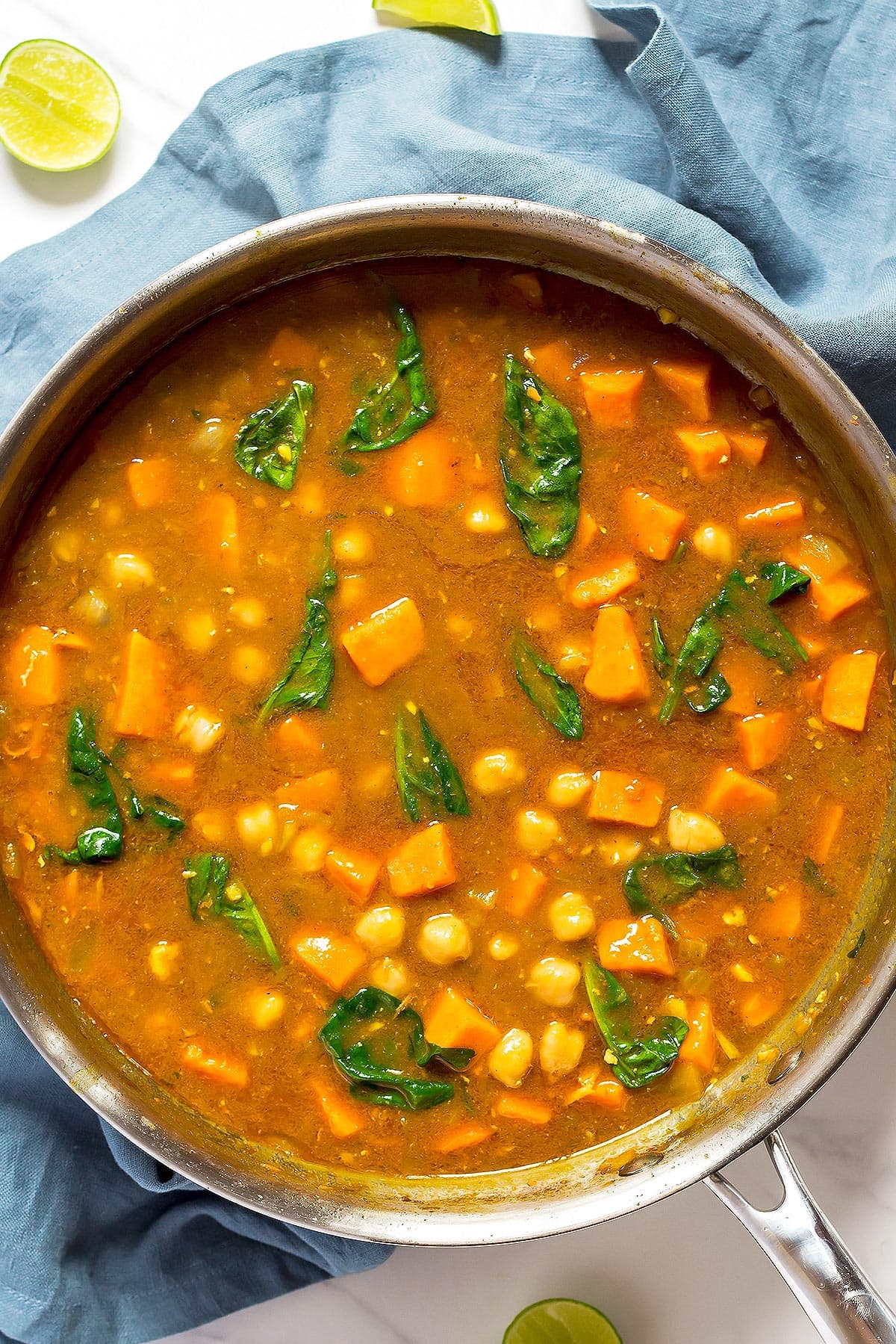
The Benefits of Curry Paste
Curry paste is so good because it packs a punch of flavour into a dish like coconut curry within a short amount of time. Curry pastes come in a few varieties. These include Thai red, Thai green, and massaman, however, I use the yellow here. They are all wonderful in coconut-based curries and soups, or even to use in rubs and marinades for meat. The paste ingredients can vary between different brands but are usually pretty similar, consisting of ingredients like fragrant galangal, garlic, chilies, kaffir lime leaves and lemongrass all finely ground into a paste.
Curry paste is also suitable for vegans (most of the time), which makes this curry recipe fine for almost anyone you serve it to. Authentic curry paste often will consist of shrimp paste, but most store brands don't contain it. If in doubt, though, just check the label to make sure it is suitable for whatever diet you enjoy.
Using curry paste in the flavour base of this dish is one of the things that makes it excellent for a weeknight meal, but you could make your own if you can get hold of all the usual ingredients. Asian markets are usually a good way to get hard-to-find ingredients.
Galangal might be one of the most difficult components to find, but fresh ginger is a good choice too. Once you have them, you can grind them together in a food processor or even with a mortar and pestle until they become smooth and paste-like. This takes a little more work but can help create a very fresh and fragrant tasting paste.
Alternative Substitutes
If you are someone who makes vegetarian meals often, chances are you have vegetable broth in the pantry already. A person looking to add meatless meals into their diet who already has chicken broth on hand could use that instead, though. It will definitely be just as good rather than purchasing a carton from the store.
Making broth at home is so easy, and you can easily do it with both leftover roasted chicken bones or veggies scraps like peelings. Simply place your bones and/or veggie scraps in a crockpot with some seasonings, and allow to cook overnight. Broths like this are great for stretching out food that might otherwise get thrown out. Plus, if you can't use it all at once, you can put it in the freezer for later.
For more details on homemade broth, check out my recipes for:
Spinach is such a wonderful option for that pop of green in this sweet potato curry, but many people grow Swiss chard for its regenerative nature. Swiss chard is an amazing alternative to spinach. To use it, just choose the most tender leaves, remove the stems, and tear or chop the leaves into small pieces.
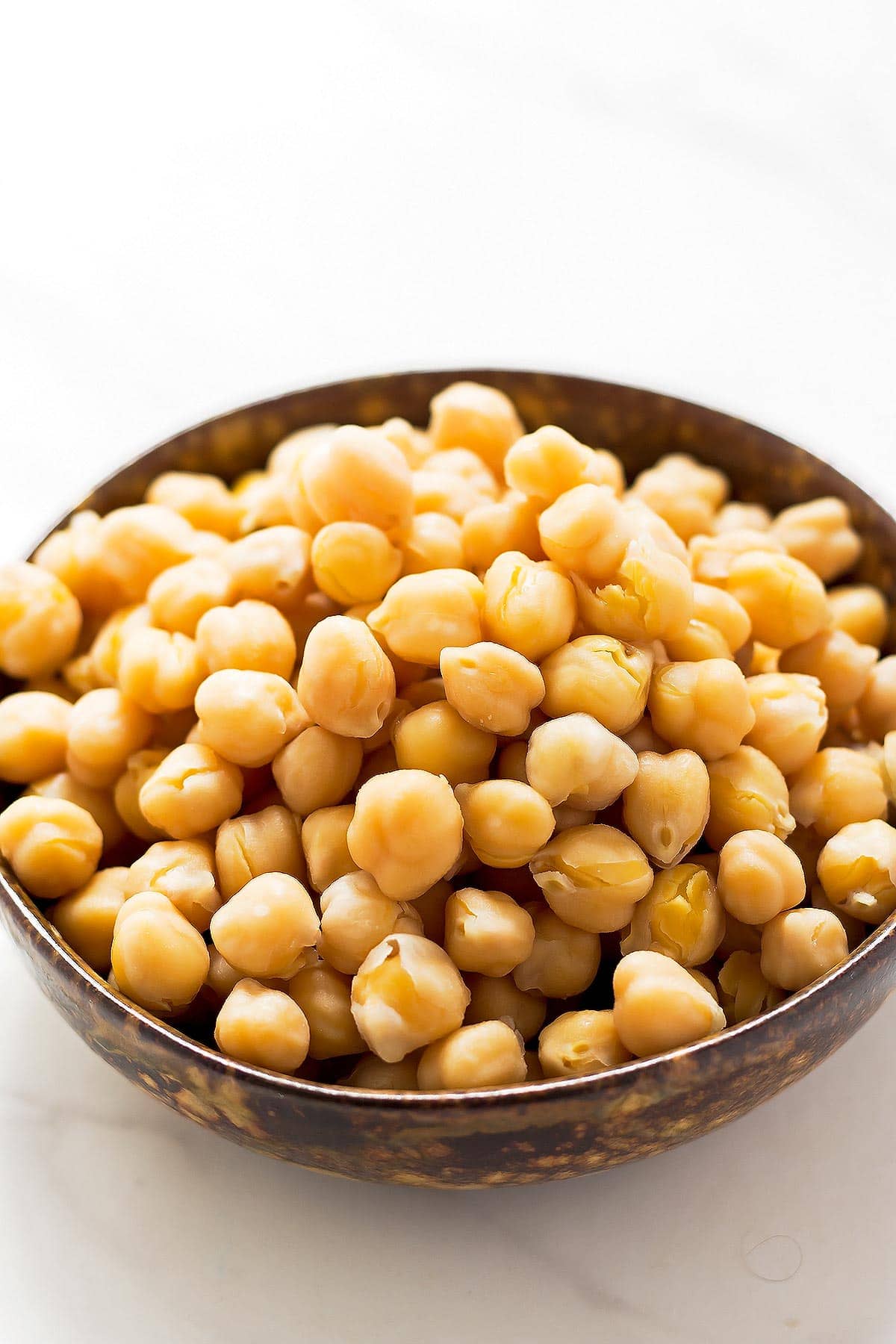
Canned or Dry Chickpeas?
This sweet potato curry recipe uses canned chickpeas. This makes it easy to make this coconut curry in under an hour on a busy night. Always drain and rinse the chickpeas, as this makes them easier to digest. It also gets rid of some of the sodium content. It is always amazing to have several cans of these stocked in the pantry to add to meals on a whim.
Sodium-restricted dieters, however, may want to add no salt or low-sodium chickpeas instead, if rinsing the chickpeas doesn't lower their sodium enough. Alternatively, you could cook a large batch of dried chickpeas to use when desired. One 15-ounce can of drained chickpeas is equal to 1 ½ cups cooked chickpeas.
I personally love to make large batches of dried chickpeas to pop in the freezer for later meals. I use this Instant Pot Chickpeas recipe, which is more affordable than using cans.
Soy Sauce or Coconut Aminos?
People often finish their Thai curry dishes with fish sauce. As a vegan alternative, soy sauce or coconut aminos give this spinach and chickpea curry some oomph in the form of umami and salt. There aren't that many differences between them. Soy sauce is fermented soybeans with wheat and salt. Meanwhile, coconut aminos is a combination of aged coconut blossom sap and salt. Coconut aminos is generally lower in sodium than soy sauce, but otherwise is a good substitution for soy sauce in this coconut curry.
There is some debate over whether soy sauce is suitable for vegan or vegetarian diets. The typical ingredients are all vegan/vegetarian-friendly, however, some manufacturers might add some fish sauce to their products. Just check the label to be sure that the soy sauce is absolutely suitable for the diet you are following. If in doubt, though, coconut aminos is a tremendous choice.
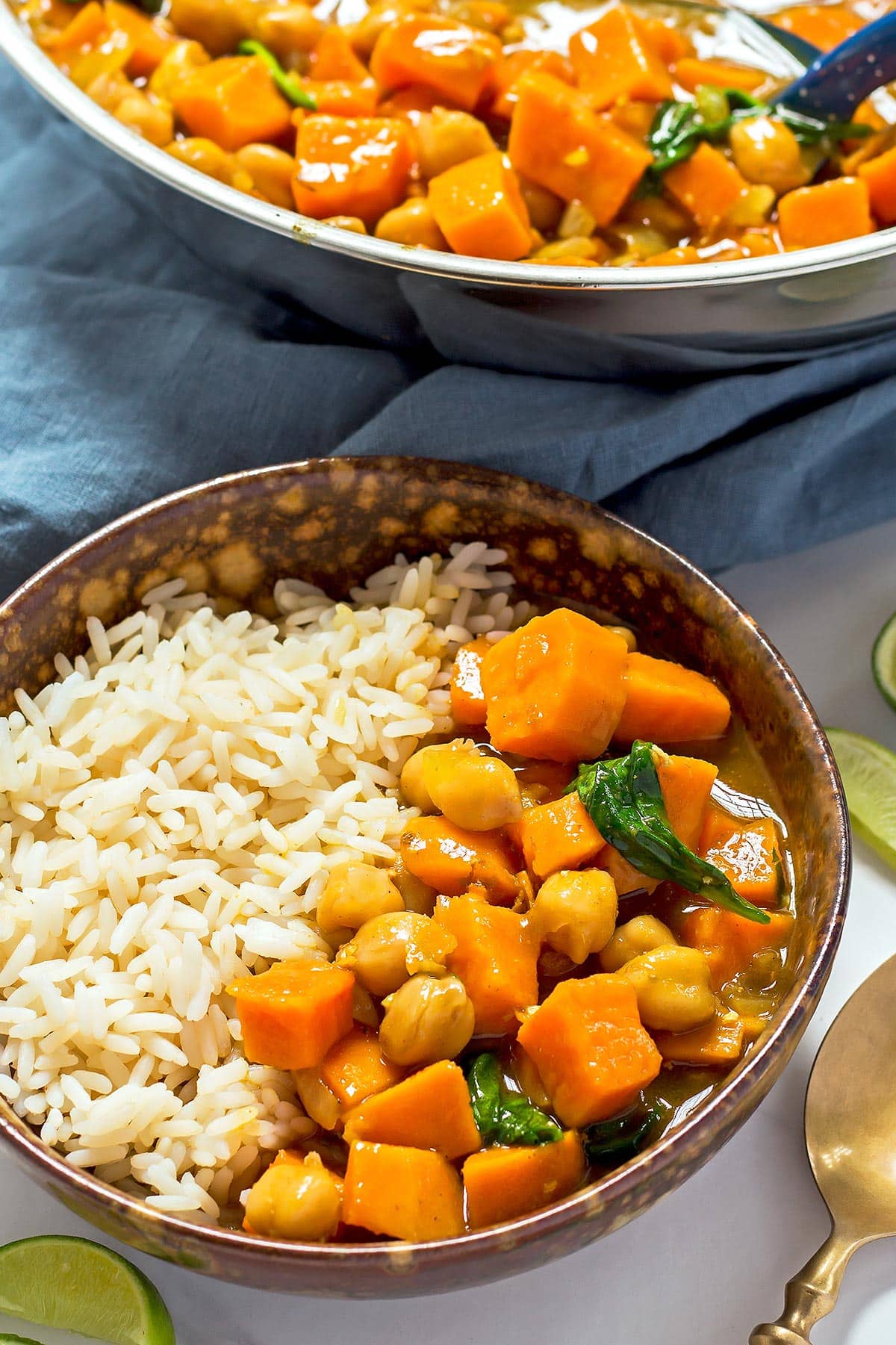
Can You Freeze Chickpea Curry?
Yes, you definitely can, however, there are a few things you will want to keep in mind. While the sweet potatoes, chickpeas, and other ingredients in this coconut curry should hold up well in the freezer, it would be ideal to leave the spinach out if you plan to freeze it for later use.
The reason is that the spinach will darken and not look as appealing in the curry. Since it only takes a few minutes to wilt, you can just add the spinach at the end when you reheat your curry with sweet potatoes and chickpeas. While you are at it, you can also taste and season with more lime juice. Flavourings can deteriorate in the freezer so it is good to check your seasonings.
To freeze this sweet potato chickpea curry recipe, you can place it in a sealable container or freezer bag. Alternatively, you can use several if you don't have one large enough. The curry should hold up well for up to 3 months, however, after that, the textures and flavours may deteriorate so try to use it within that time frame. This is something you can apply to your other bean-based dishes like chili or baked beans, too.
Random Questions
Chickpea curry typically contains sweet potatoes, chickpeas, coconut milk, and various spices. It's often seasoned with curry paste or powder, and it can include additional vegetables like spinach or Swiss chard for added nutrition and flavor.
Yes, you can freeze chickpeas in curry. However, it's advisable to leave out ingredients like spinach that might not freeze well. Add the spinach when reheating the curry to maintain its texture and appearance.
The calorie content of vegetable chickpea curry can vary based on the specific ingredients and quantities used in the recipe. Generally, vegetable-based curries are relatively low in calories, especially when compared to meat-based curries.
Vegan curry is typically made of plant-based ingredients such as vegetables, legumes like chickpeas, and various herbs and spices. It often includes a coconut milk or tomato base and can be seasoned with curry paste, powder, or a combination of aromatic spices.
Curries that do not contain any animal-derived ingredients, such as meat, dairy, or eggs, are considered vegan. Plant-based curries are often made with ingredients like vegetables, legumes, and vegan-friendly seasonings to create rich, flavorful dishes.
Instead of meat, you can add various plant-based protein sources to your curry, such as tofu, tempeh, or seitan. These ingredients can mimic the texture and flavor of meat while providing a satisfying and nutritious alternative in your curry.
A variety of vegetables can be added to curry to enhance its flavor and nutritional profile. Common options include spinach, Swiss chard, carrots, bell peppers, and cauliflower, among others. These vegetables can contribute to the overall texture and taste of the curry.
More Curry Recipes You'll Love:
Recipe
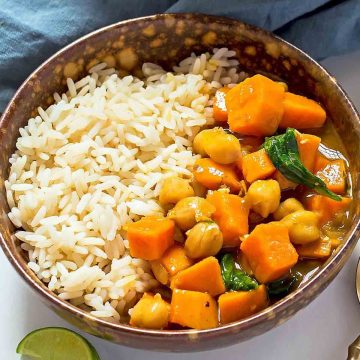
Sweet Potato Chickpea Curry
Ingredients
- 2 tablespoons oil olive or coconut oil
- 1 medium onion chopped
- 3 garlic cloves minced
- 2 tablespoons yellow curry paste vegans watch for curry paste without shrimp paste
- 1 tablespoon curry powder
- 1 15- ounce can coconut milk
- 1 cup vegetable broth
- 1 teaspoon coconut sugar or brown sugar
- 1 large sweet potato (or 2 medium-small ones) cubed
- 1 15- ounce can chickpeas drained (or 1.5 cups cooked chickpeas)
- 1 tablespoon soy sauce or coconut aminos
- juice of 1 lime or to taste
- 2 cups fresh spinach
Instructions
- Heat a large pan or skillet. Add the oil and sauté the chopped onion until soft and translucent. Add minced garlic and cook until fragrant (1-2 minutes).
- Now, add the yellow curry paste. Spread it around the pan as best as you can, so it gets fragrant throughout.
- Then, stir in curry powder and add coconut milk and vegetable broth.
- Stir in coconut sugar. Add the sweet potato cubes and drained chickpeas. Close with a lid and simmer until the sweet potato dices are softened (15-20 minutes).
- Remove the lid and taste the curry. Adjust flavors with soy sauce/coconut aminos for saltiness and a squeeze of lime juice for acidity.
- Add in the fresh spinach. Stir and cook a couple more minutes until the spinach has wilted.
- Serve this Chickpeas Sweet Potato Curry alongside steamed rice or quinoa. Serve with chopped cilantro (fresh coriander) and lime wedges.
Nutrition
Pin Sweet Potato and Chickpea Curry recipe for later?



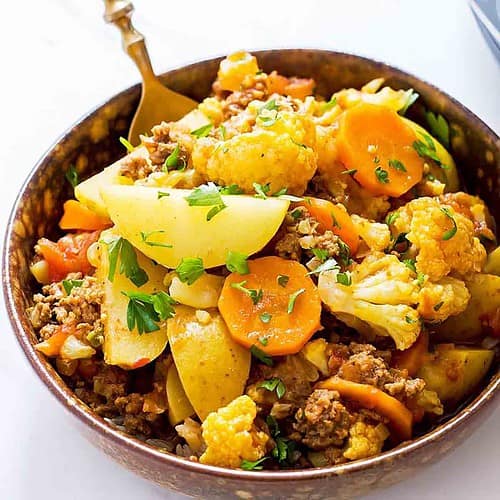
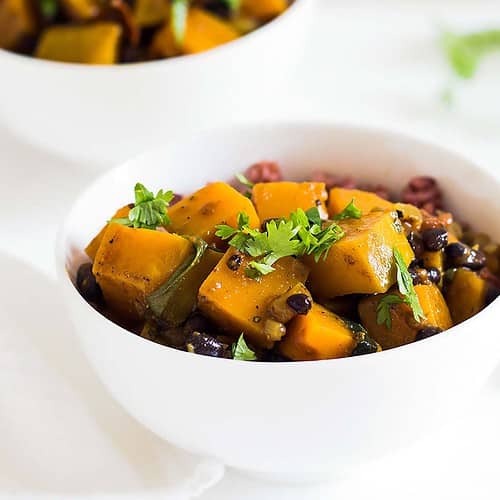
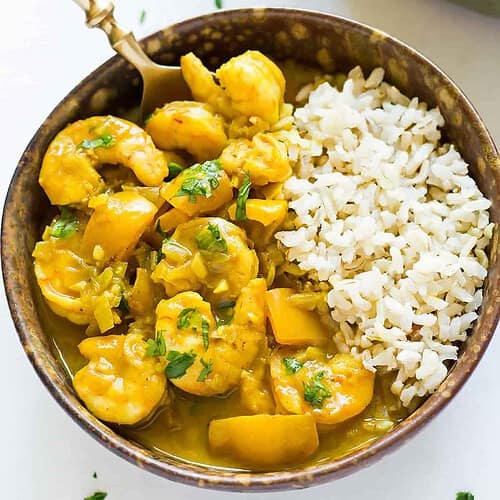
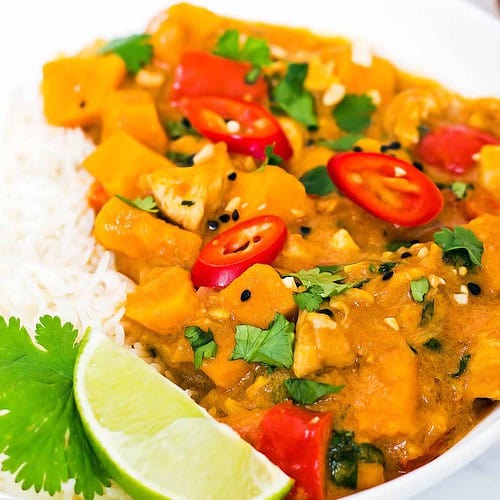
Leave a Reply